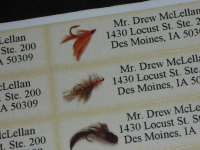Do you want a 340 lb exercise instructor?
February 8, 2007
Last week, The Wall Street Journal wrote an article about a new exercise (Nordic Walking) that targets the "less than fit." Part of the effort to lure the couch potatoes and non-athletic type people into an exercise class is to have overweight instructors lead the group.
In the article one of the instructors, the 340 lb. Donna Mirabile, explains the tactic as "we want people to think if big fat Donna can do it, so can they."
Hmm.
Now the politically correct answer of course, is…it doesn’t matter how much she weighs. And maybe it doesn’t.
But I find myself wondering if this isn’t a case of someone marketing based on what they wish people thought/wanted rather than either recognizing or wanting to acknowledge the not so flattering human truth. (Sort of like the recycling movement.)
I get the whole before and after technique that is rampant in weight loss marketing. They show a picture of "big fat Donna" and then we see the after version "svelte, sexy Donna" while she tells us she could still eat chocolate. The premise of these ads is to encourage the mental leap — if Donna can transform herself, so can I.
But if "big fat Donna" is leading the class and she is still "big fat Donna" does that imply that you’re going to stay "big fat you?"
Be honest — both women are friendly, kind, love animals. But one is fit and one is fat. Who would you, as a consumer, want to take the exercise class from?
Do you think it matters, from a marketing perspective?
More


![Reblog this post [with Zemanta]](http://img.zemanta.com/reblog_e.png?x-id=90dafd6f-3c32-47ce-9940-3c5abe1e0296)

![Reblog this post [with Zemanta]](http://img.zemanta.com/reblog_e.png?x-id=8b417565-1349-4cf0-ac16-b63a258e7bdd)
![Reblog this post [with Zemanta]](http://img.zemanta.com/reblog_e.png?x-id=cdb04012-8724-445d-835a-38f044deb663)

![Reblog this post [with Zemanta]](http://img.zemanta.com/reblog_e.png?x-id=0b2738d7-95b9-4ff4-9580-a6bc098d8fbd)

![Reblog this post [with Zemanta]](http://img.zemanta.com/reblog_e.png?x-id=7606f0b3-a619-486b-94e7-083aa0aa9185)

![Reblog this post [with Zemanta]](http://img.zemanta.com/reblog_e.png?x-id=128561d0-1480-4fc8-be13-9fd172595426)

![Reblog this post [with Zemanta]](http://img.zemanta.com/reblog_e.png?x-id=f72f7414-e8ab-4746-a611-ccded27dd3db)

![Reblog this post [with Zemanta]](http://img.zemanta.com/reblog_e.png?x-id=7f8e6ae1-4110-4c26-8df4-f3b951931ee1)

![Reblog this post [with Zemanta]](http://img.zemanta.com/reblog_e.png?x-id=08c277ec-de54-4d40-8f3d-3d0c58d1c562)


![Reblog this post [with Zemanta]](http://img.zemanta.com/reblog_e.png?x-id=7f1d39d6-eee1-4b52-81be-30c187371e82)